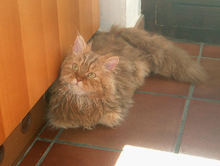Selkirk Rex
Selkirk Rex is a pedigree cat , which is characterized by a curly fur.
General
It was first discovered in the USA in 1987 . A supposedly common house cat was given to an animal shelter . It quickly became apparent, however, that one of the boys was different from the others. A blue-cream-white female from the litter had completely different fur than the other siblings in the litter. The color of the eyes was also different from the others. The eyes were bright green and the fur was short and curly. It was also noticeable that the whiskers were not straight, as usual, but also frizzy. Since they were of the opinion that this must be a special kitten, it was passed on to the breeder Jeri Newman. There it was named Miss Depesto of Noface.
Jeri Newman was a well-known Persian breeder in the USA and soon decided to breed the strange cat. In the course of the first considerations, a name for the new breed had to be found. After much deliberation, she decided on the name Selkirk Rex. Selkirk in honor of your father-in-law - Rex for the curly coat.
A little over a year after Miss Depesto moved in with Jeri Newman, she decided to breed Miss Depesto to a black Persian male.
The mating resulted in six healthy kittens. Three of them were born with curls and three with normal fur. From this mating it could be seen that the curls had to be present as a dominantly inherited genetic trait. So it is completely sufficient that one of the parent animals has curly fur. The cats are not related to any other Rex species. For example, the short curls of the Devon Rex or Cornish Rex are inherited recessively.
Appearance
In a Selkirk Rex litter you will mostly find curled and non-curled young. The curly boys are immediately recognizable. The whiskers are already curled, and the fur also has the curls that will later be pronounced. Since the Selkirk Rex breed is still a very rare breed, breeders these days are working to expand the gene pool. Therefore, Selkirk Rex are not bred, but rather by mating with cats of the breeds Exotic Shorthair, Persian and British Shorthair .
The different matings produce very different young. If you mate Persians with Selkirk Rex, for example, both long-haired and short-haired cubs are created. The mating of the British Shorthair with Selkirk Rex, on the other hand, usually produces mostly short-haired curls.
The type of a Selkirk Rex is still very different due to the different mating partners. However, it is said to be heading towards the British Shorthair. A Selkirk Rex cat is stocky, strong and stands on thick paws. The build is compact. Overall, the cat makes a round and powerful impression. The head is also round, with small to medium-sized ears. The chin is strong. The nose is short, but never has a stop . The eyes are large, round, and set wide apart. The coat of the Selkirk Rex is fluffy, soft and curly. The short hair variant has short, grippy curls that mostly end in small curls behind the ears, on the neck and on the stomach. The long-haired cats have half-length fur with larger curls. Usually, the curls are a little more pronounced in the long hair variant.
Selkirk Rex cats are very affectionate cats, which breeders also refer to as dog cats. They love to be close to their human being all day. They are calm cats and like to be with other conspecifics.
genetics
The hair type of cats is inherited as an autosomal dominant trait. This is due to a mutation in the KRT71 gene, a gene that codes for the protein keratin 71. It has essential functions in the structure of hair. Loss of the activity of the gene leads to the hair breaking off, as in the Sphynx cats. In addition to Selkirk Rex and Sphynx, mutations of this gene have also been determined to be the main reason for the development of the fur in Devon Rex cats. Here is allele of Selkirk (SADRE) dominant over the wild-type variant (+), which in turn dominates Devon Rex (right) and ultimate recessive hairless Sphynx allele (hr) (KRT71SADRE> KRT71 +> KRT71re> KRT71hr). The mutation found in the Selkirk Rex KRT71 is unique and has not been identified in any other Rex cats.
Individual evidence
- ↑ Selkirk Rex cats - character and history. Retrieved August 28, 2018 .
- ↑ Barbara Gandolfi, Hasan Alhaddad, Shannon EK Joslin, Razib Khan, Serina Filler, Gottfried Brem, Leslie A. Lyons: A splice variant in KRT71 is associated with curly coat phenotype of Selkirk Rex cats. In: Scientific Reports . 3, 2013, Article 2000, doi: 10.1038 / srep02000 .
- ↑ Barbara Gandolfi, Catherine A. Outerbridge, Leslie G. Beresford, Jeffrey A. Myers, Monica Pimentel, Hasan Alhaddad, Jennifer C. Grahn, Robert A. Grahn, Leslie A. Lyons: The naked truth: Sphynx and Devon Rex cat breed mutations in KRT71. In: Mammalian Genome. Vol. 21, No. 9/10, 2010, ISSN 0938-8990 , pp. 509-515, doi : 10.1007 / s00335-010-9290-6 .




